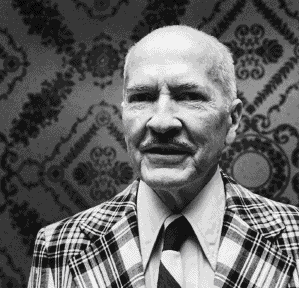robert a heinlein and the old solar system
[ + links to: The Green Hills of Earth (podcast) -
The Implicizer Aimed at "Blowups Happen" - Red Planet -
Slaves of Venus - Starship Troopers (podcast) - They (podcast) ]

Heinlein, one of the very greatest sf authors, fortunately set many of his tales in the Old Solar System. The list below is not exhaustive. Heinlein's Future History stories are collected in The Past Through Tomorrow.
Poetic grandeur in Heinlein is not to be found in word or line or paragraph but rather in his work as a whole. The breadth of his knowledge, his fascination with the way things work, his flair for narrative and his prolific output remind one of Poul Anderson, though Anderson is more the scientist and Heinlein more the engineer. Both combine technical knowledge with romantic vision; however, unlike Anderson and the equally scientific (and even more poetical) Arthur C Clarke, Heinlein can be criticized for not conveying a sense of "place" in his planetary scenes: for example if you compare The Moon is a Harsh Mistress (an excellent yarn, a rousing tale of revolution in a lunar colony) with Clarke's Earthlight, you feel Heinlein's Moon is a mere prop, compared with Clarke's wonderful evocation.
But this stricture does not apply to Red Planet, which is a glorious success in any terms, one of the best evocations of Mars ever written.
settings
Plying the space-lanes: The Green Hills of Earth
Venus: Space Cadet; Between Planets; Logic of Empire
Earth: The Man Who Sold The Moon (for the Old Space Program); sundry Future History stories
The Moon: many of his Future History short stories set on a colonized Moon; also, the novel The Moon is a Harsh Mistress.
Mars: Red Planet; Double Star; The Green Hills of Earth
Arthur C Clarke, Earthlight (1955); Robert A Heinlein, Between Planets (1951);Farmer in the Sky (1950); "Logic of Empire" (Astounding Science Fiction, March 1941);The Man Who Sold The Moon (written 1949, published 1950); The Moon is a Harsh Mistress (1966);Red Planet (1949); Space Cadet (1948); Double Star (1956); The Past Through Tomorrow (1967)
Logic of Empire is discussed by Dylan Jeninga in the Travelogue page, Slaves of Venus.
D D Harriman's longing for the Moon in Requiem is discussed in the Diary,
Cathexis in C S Lewis and Heinlein.
The Harriman of The Man Who Sold The Moon is compared with
Elon Musk in Musk Aiming at the Wrong Target. For an extract about
hiring brains, see How to Get There.
See also the Gazetteer with regard to Peterson Field and Pike's Peak.
And the fictional date 1978.
For the location of Luna City, and an extract from It's Great To Be Back, see the Gazetteer entry for Mare Fecunditatis.
For what an "implicizer" might make of Between Planets see the Diary, 5th November 2016.
For more on Double Star see the Diary, 9th November 2016.
For the mystery of the lunar craters as set out in Blowups Happen, see
De-Luxe Science-Patter.
See also The Implicizer Aimed at "Blowups Happen".
For RAH's sensible attitude re the heritage of our Solar System see
Heinlein in support of OSS Venus.
For a podcast on ...And He Built a Crooked House, see Roll Off A Tangent 35.
For a podcast on They, see Roll Off A Tangent 27.
Gazetteer references: For "If This Goes On - " see St Louis and Kansas City; for The Puppet Masters see: the Adirondacks - Grinnell - Kansas City; for The Man Who Sold the Moon see Petersfield and Pike's Peak.
For The Moon is a Harsh Mistress see Mare Undarum.
Fictional Dates: for Methuselah's Children see 2075.
For Space Cadet see 1981.
Extracts: Viewing memories on Mars - Farming on Ganymede - Economics of survival on the Moon - Dragonville on Venus - Matriarchal amphibians on Venus - Using a machete on an insect on Venus.
>> Authors





































